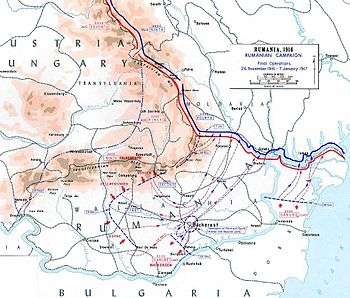Battle of Bucharest
| Battle of Bucharest | |||||||
|---|---|---|---|---|---|---|---|
| Part of the Romanian Campaign of World War I | |||||||
 Falkenhayn's cavalry entering Bucharest on 6 December 1916 | |||||||
| |||||||
| Belligerents | |||||||
|
|
| ||||||
| Commanders and leaders | |||||||
|
|
| ||||||
| Strength | |||||||
| 150,000 | 250,000 | ||||||
| Casualties and losses | |||||||
|
60,000 soldiers 85 artillery pieces 115 machine guns[1] | unknown | ||||||
The Battle of Bucharest, also known as the Argeş-Neajlov Defensive Operation in Romania, was an important battle of the Romanian Campaign in World War I, in which the Central Powers occupied the Romanian capital and forced the Romanian Government, as well as the remnants of the Romanian Army to retreat to Moldova and re-establish its capital at Iaşi. The sheer number of troops involved, as well as the large area of operations, make it one of the most complex battles fought on Romanian soil during the war.
Background
After three months of heavy fighting, the Central Powers finally managed to push all Romanian troops beyond the Olt river on 26 November 1916. The next day, they began their advance towards the city. The Prunaru Charge launched by the Romanian Cavalry the following day managed to delay the Central Powers, giving precious time to the Romanian forces who were building up east of the Argeș river.
Battle
On 1 December, the Romanian Army began its attack, striking the 20 km wide gap between the Mackensen and Falkenhayn groups. German General Erich Ludendorff considered the situation to be very serious: "On 1 December the left flank of the Danube Army was very powerfully attacked South-West of Bucharest and pushed back. The German troops who crossed the Neajlov were cut off and isolated. The situation most certainly became very critical."[2]
Romanian forces captured thousands of prisoners and significant quantities of material during this counter-offensive and only the last-minute intervention of the 26th Turkish Infantry Division on 2 December saved Mackensen's group from encirclement.[3]
The Romanians suffered a considerable setback when a staff car carrying attack plans accidentally drove into a German position and was captured.[4] These plans were vital to the Germans, as they soon managed to push back the Romanian forces, leaving the way to the capital open.
Aftermath
After the battle, minor actions were fought in the fortifications surrounding Bucharest between the invading Germans and the Romanian reserves which had failed to arrive due to the actions of Alexandru Socec, a subordinate of Constantin Prezan and a naturalized German. The city was eventually occupied by the Central Powers on 6 December. However, in spite of the human, material and military efforts made by the Central Powers throughout this period, they failed to achieve their fundamental political and strategic goal, namely Romania's defeat and her getting out of the war. Despite heavy casualties, some 250,000 men, which were almost one third of the manpower mobilized in August 1916, and losses of combat material, the Romanian Army was still a force taken into consideration by allies and enemies alike and capable to offer resistance to further attacks. Before retreating, Romanian troops burned down the oil wells at Ploiești along with the surrounding wheat fields so as to keep them out of the hands of the Central Powers.
Bucharest was eventually liberated after the Central Powers' surrender in 1918.
-

Operations in Romania, November 1916 to January 1917